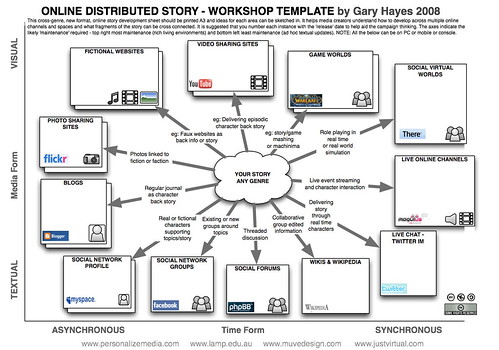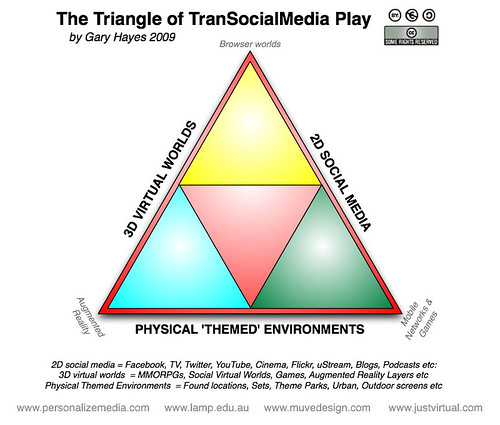OK, look….I’m not particularly well organized which is, for me, a revelation…you probably figured it out already, right? I was reading Common Sensible’s brilliant post on Linden Lab’s content roadmap and how to lobby for change in Second Life and embedded in there somewhere was a mention of this blog and the fact that I tend to ramble and that’s when it struck me: it’s not that I ramble, it’s that there isn’t really that much structure to my thought processes. I mean, I never hear someone say that “War and Peace” tends to ramble, so it’s not an issue of length really is it?
I can’t help wondering if virtual worlds are somehow responsible for a great deal of, hmmm, tangents let’s call it. I made a comment to someone once which to my slight embarrassment made it into their profile: “I had a purpose, but as soon as I log on I forget what it was.”
Meaning, the Grid immediately sets off some sort of brain chemistry which compels me to keep a disorganized inventory and to wander from place to place clicking ‘teleport now’ buttons. Now, just having finished ‘Create Your Own Economy’ (a book about which I’ll, um, ramble later) I can’t help wondering whether the Grid encourages a kind of neurodiversity that I don’t get elsewhere with the exception of maybe this blog, and my browser tabs.
See how I go off on tangents? Because I have a question: how many tabs do you have open in your browser and how long do they stay open for?
In any case, bear with me, because this morning I resolve to close a few of my tabs and, if I still have the strength, to catch up on the backlog in my RSS reader, and somehow between all that pack for SLCC while I use my iPhone widgets to try to figure out what the weather will be on the west coast.
So here’s what I’ve had in my tabs….consider this whole exercise one of “bite sized rambles” if you will, or just move on and we’ll catch up on deeper stuff later:
Where Sensors Meet Virtual Reality

MIT’s Responsive Environments Group is doing work on “Cross Reality”, which is where sensor/actuator networks meet online virtual worlds. (I don’t know what an actuator network is but I guess it means it’s in the actual world). Reports Read Write Web:
“MIT has also created a whole portal network that maps sensors to virtual worlds, called the Ubiquitous Sensor Portal. There are 45 portals currently in the Media Lab, each one featuring a myriad of environmental sensors – such as motion, light and sound level, vibration, temperature, and humidity. They have a small touch-screen display and audio speaker, for user interaction.
The Portals also act as base stations for an 802.15.4 network inside the lab, “enabling wireless communication with a variety of wearable sensors.” Each portal has an extension into Second Life, allowing people to visit the Media Lab virtually. This isn’t just a one-way process either; as well as affecting virtual worlds, portal interactions can push virtual phenomena into the user’s physical space.”

The piece concludes: “The group is still exploring both the technical and practical sides of this, so it’s uncertain what it will lead to in the commercial world. But we’re certain it will fuel future startup innovation in the coming year or two. Watch this space!”
And yeah, I can’t think of anything immediately that’s a natural, sure-fire, “yes we need to have this” reason why I’d run virtual world content from real world sensors….some applications in health spring to mind, I suppose. But that’s why the tab has been open for so long.
Intel’s Pitch for ICE
I keep glancing at this post on Intel’s vision of the 3D Web, where they claim that Second Life isn’t as immersive as things WILL be, and think about either making a snarky comment or trying to figure out whether they’ve said something brilliant by coming up with the new acronym “ICE”:
“In his keynote address to the Semicon 2009 conference Intel’s director of technology management and microprocessor research Jerry Bautista said Intel was working towards the internet becoming an immersive connective experience (ICE) where devices would increasingly overlay the digital world onto reality.
“There is another web coming, an ICE web,” he said.”
But I guess I can’t decide whether giving it a new acronym makes this particularly brilliant, although there are some interesting predictions:
“Another example of this came from letting users generate their own 3D images, by sending in 20 pictures of an object to be rendered and letting the computer build the object automatically.
He estimated that the techniques of using the camera to produce visual searches for data of photographed object would come online in 2010, with information overlay on camera views by 2012 and a 2D and 3D visual overlay available by 2014.”
But that’s kind of a no-brainer, since this stuff already exists really, even if only in a lab somewhere. Which takes me to tab three….
Building Rome in a Day

Second Life was inspired by Snow Crash of course, but somehow this is more evocative of that novel for me, and I have no idea why:
According to the project Web site:
“In this project, we consider the problem of reconstructing entire cities from images harvested from the web. Our aim is to build a parallel distributed system that downloads all the images associated with a city, say Rome, from Flickr.com. After downloading, it matches these images to find common points and uses this information to compute the three dimensional structure of the city and the pose of the cameras that captured these images. All this to be done in a day.
This poses new challenges for every stage of the 3D reconstruction pipeline, from image matching to large scale optimization. The key contributions of our work is a new, parallel distributed matching system that can match massive collections of images very quickly and a new bundle adjust software that can solve extremely large non-linear least squares problems that are encountered in three dimensional reconstruction problems.”
(Nod to Pais for the link).
Are Virtual Worlds Acceptable to Kids for Education?
A random stat culled from a larger piece on a session on energy sustainability facilitated by IBM with students:
“The “Jammers” foresaw the need to create a new model of university education around smarter campuses that are interconnected, enriched and fed by on-the-ground knowledge developed over social networks. Such universities would incorporate broader use of virtual environments and videoconferencing to enhance learning, interaction, networking and communication. In a poll conducted during the Jam, 82 per cent of those polled said they believed “virtual worlds” are a great place to learn future skills.”
Games and Virtual Worlds – With Graphs!
Here’s another post that is probably profound but that I can’t seem to find the time to wrap my head around. But I keep the tab open because the graphs are really cool:


Towards a Semantic 3D Web
Yes! Yes! Quote:
“Let’s not repeat the mistake of application development and the web. Let’s start thinking about virtual worlds in terms of how we semantically mark up their content, and then treat the display issue as a second order problem. The virtual world is not HOW you see it, it’s WHAT you see (or more precisely what you sense and interact with).”
Now, it’s a slightly disguised pitch for the approach taken by PIVOTE, but what the heck.
OK, so that helps clear out some of my “major tabs”. The rest of them are about “How to be Better Organized in 10 Easy Steps” and things like that, so let me get to those and see if I make more sense later.


An “actuator” is a physical device controllable from the digital realm. Like a robot arm, for example. Easy to get hypnotized by MediaLabSpeak… miss real words.
haha – thanks Maggie!
I have been (half-heartedly, I admit) trying to focus for 2-1/2 years. Second Life is so vast, so interesting, and has so many distractions (Oooooo, sparklies! … Ooooo, art! … Ooooo, interactive content! … etc.) that it is very easy to ramble – verbally, metaphorically, and actually. Also, um, virtually. Good luck!
How many tabs do I have up? Between six and ten, depending on the day. =D I think the people attracted to virtual worlds tend to be dedicated multi-taskers. And you don’t ramble, Dusan—you have a wide variety of interests and experiences which are reflected in your writing style.
Awww you guys rock.
/me wanders idly off following a little wisp of some sort that just floated by
*wonders if he ought to review his profile* … and I agree with Doreen. Having been exposed to more than just a little bit of ramb…er…wide variety of interests, there does seem to be a method to the madness. It’s not lost or dissociated, just occasionally distracted. I see that as a good thing. If everyone was so totally focused on what was directly in front of them, things like art, music, stories, and other vitally human expressions would be so BORING. It’s these little tracers and sparkles in the corners of our eyes that keep life interesting.
… and I agree with Doreen. Having been exposed to more than just a little bit of ramb…er…wide variety of interests, there does seem to be a method to the madness. It’s not lost or dissociated, just occasionally distracted. I see that as a good thing. If everyone was so totally focused on what was directly in front of them, things like art, music, stories, and other vitally human expressions would be so BORING. It’s these little tracers and sparkles in the corners of our eyes that keep life interesting.
You like ICE as an acronym? I prefer mine – PIE – Persistent Immersive Environments = everyone likes PIE right?
PIE! Berry pie, peach pie, strawberry-rhubarb pie, lemon, pie, blueberry pie, custard pie…and quiche! Spinach quiche, mushroom-zuchinni quiche, hmmm, zuchinni!….